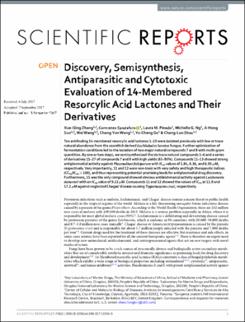Mostrar el registro sencillo del ítem
Discovery, Semisynthesis, Antiparasitic and Cytotoxic Evaluation of 14-Membered Resorcylic Acid Lactones and Their Derivatives
| dc.contributor.author | Zhang, Xue-Qing | |
| dc.contributor.author | Spadafora, Carmenza | |
| dc.contributor.author | Pineda, Laura M. | |
| dc.contributor.author | Ng, Michelle G. | |
| dc.contributor.author | Sun, Ji-Hong | |
| dc.contributor.author | Wang, Wei | |
| dc.contributor.author | Wang, Chang-Yun | |
| dc.contributor.author | Gu, Yu-Cheng | |
| dc.contributor.author | Shao, Chang-Lun | |
| dc.date.accessioned | 2020-06-17T18:39:48Z | |
| dc.date.available | 2020-06-17T18:39:48Z | |
| dc.date.issued | 2017-09-18 | |
| dc.identifier.other | https://www.nature.com/articles/s41598-017-12336-0 | |
| dc.identifier.uri | http://repositorio-indicasat.org.pa/handle/123456789/89 | |
| dc.description | Ten antifouling 14-membered resorcylic acid lactones 1–10 were isolated previously with low or trace natural abundance from the zoanthid-derived Cochliobolus lunatus fungus. Further optimization of fermentation conditions led to the isolation of two major natural compounds 7 and 8 with multi-gram quantities. By one or two steps, we semisynthesized the six trace natural compounds 1–6 and a series of derivatives 11–27 of compounds 7 and 8 with high yields (65–95%). Compounds 11–13 showed strong antiplasmodial activity against Plasmodium falciparum with IC50 values of 1.84, 8.36, and 6.95 μM, respectively. Very importantly, 11 and 12 were non-toxic with very safety and high therapeutic indices (CC50/IC50 > 180), and thus representing potential promising leads for antiplasmodial drug discovery. Furthermore, 11 was the only compound showed obvious antileishmanial activity against Leishmania donovani with an IC50 value of 9.22 μM. Compounds 11 and 12 showed the values of IC50 at 11.9 and 17.2 μM against neglected Chagas’ disease causing Trypanosoma cruzi, respectively. | en_US |
| dc.description.abstract | Ten antifouling 14-membered resorcylic acid lactones 1–10 were isolated previously with low or trace natural abundance from the zoanthid-derived Cochliobolus lunatus fungus. Further optimization of fermentation conditions led to the isolation of two major natural compounds 7 and 8 with multi-gram quantities. By one or two steps, we semisynthesized the six trace natural compounds 1–6 and a series of derivatives 11–27 of compounds 7 and 8 with high yields (65–95%). Compounds 11–13 showed strong antiplasmodial activity against Plasmodium falciparum with IC50 values of 1.84, 8.36, and 6.95 μM, respectively. Very importantly, 11 and 12 were non-toxic with very safety and high therapeutic indices (CC50/IC50 > 180), and thus representing potential promising leads for antiplasmodial drug discovery. Furthermore, 11 was the only compound showed obvious antileishmanial activity against Leishmania donovani with an IC50 value of 9.22 μM. Compounds 11 and 12 showed the values of IC50 at 11.9 and 17.2 μM against neglected Chagas’ disease causing Trypanosoma cruzi, respectively. | en_US |
| dc.language.iso | eng | en_US |
| dc.rights | https://creativecommons.org/licenses/by-nc-sa/4.0/ | |
| dc.rights | info:eu-repo/semantics/openAccess | |
| dc.subject | Discovery | en_US |
| dc.subject | Semisynthesis | en_US |
| dc.subject | Antiparasitic and Cytotoxic | en_US |
| dc.subject | Evaluation of 14-Membered | en_US |
| dc.subject | Resorcylic Acid Lactones | en_US |
| dc.subject | Their Derivatives | en_US |
| dc.title | Discovery, Semisynthesis, Antiparasitic and Cytotoxic Evaluation of 14-Membered Resorcylic Acid Lactones and Their Derivatives | en_US |
| dc.type | info:eu-repo/semantics/article | en_US |
| dc.type | info:eu-repo/semantics/publishedVersion |

